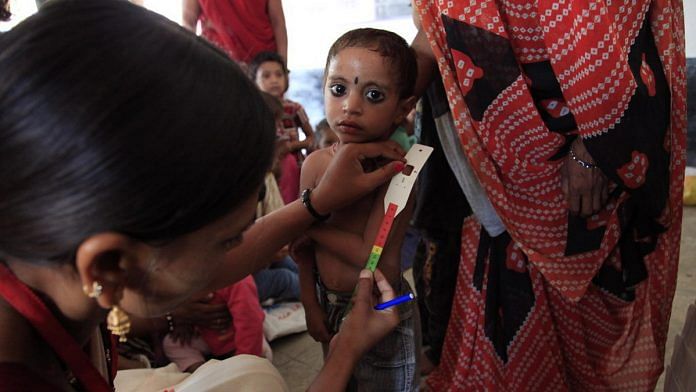New Delhi: The burden of child stunting — a measure of chronic malnutrition — has come down in India, according to the latest survey by the Ministry of Health and Family Welfare.
The Comprehensive National Nutrition Survey (CNNS) 2016-18, an extensive online dashboard released last month, showed that the number of stunted children below five years of age has come down to 3.87 crore in 2016-18 from 5.55 crore in 2005-06 — a fall of 30 per cent.
Stunting was one of the primary reasons why the mid-day meal scheme was introduced in India. It is caused by an insufficient intake of nutrients and frequent infections. The UNICEF calls it “a measure of profound physical and cognitive underdevelopment”, as it leads to a lower height than the average for a child’s age.
Data from the National Family Health Survey (NFHS) 2005-06 showed that India grappled with unacceptably high levels of stunting — 48 per cent of children below five years of age suffered from under-nutrition, with life-long consequences on human capital and poverty. The World Bank had said: “A one per cent loss in adult height due to childhood stunting is associated with a 1.4 per cent loss in economic productivity.”
The latest government data shows that stunting has fallen to 34.7 per cent, but the Global Nutrition Report 2018 also points out that India holds almost a third of the world’s burden for stunting.
Also read: India’s politicians need to wake up and see the malnutrition crisis
Rural children affected more
India has more stunted children in rural areas than urban areas — of the total 3.87 crore stunted children, around one crore live in urban areas. Nearly 44 lakh children suffering from chronic malnutrition belong to the richest parents, whereas over 1 crore belong to the poorest.
In terms of geographical regions, Uttar Pradesh suffers from very high rates of stunting, followed by Maharashtra and Bihar, with more than 1.5 crore stunted children. States with the lowest rates include Sikkim, Mizoram and Arunachal Pradesh.
Also read: UK study conducted in India finds children born into poverty have weaker brain activity
‘Slowest’ progress
The government’s aim under the National Nutrition Strategy of 2017 is to achieve a malnutrition-free India by 2022. The objective is to curb the prevalence of stunting by about three percentage points per year by 2022 from NFHS-4 levels, which stood at 38.4 per cent — around 4.38 crore children below five years of age.
However, according to Delhi-based think-tank Observer Research Foundation (ORF), there is a long way to go.
“This is an ambitious goal, especially given that the decadal decline in stunting from 48 per cent in 2006 to 38.4 per cent in 2016 is only one percentage point a year,” wrote Dr Shoba Suri, senior fellow at ORF, in a column.
“This promise calls for serious alignment among line ministries, convergence of nutrition programmes, and stringent monitoring of the progress made in achieving these goals.”
According to a report prepared by the UN World Food Programme in collaboration with the Ministry of Statistics and Programme Implementation, the rate of reduction in stunting is the “slowest” in India.
An analysis by The Hindu said: “Over the last decade, child stunting has reduced at a rate of about one per cent per year, the slowest decline among emerging economies.
“At this rate, 31.4 per cent of children will still be stunted by the 2022 deadline. India must double its rate of progress to reach the target of 25 per cent by that time.”
Also read: High-dose vitamin D could be a game changer in treating severe malnutrition







Why should be trust this governments figures.
The statistics our government releases have lost all credibility.
They will do anything to fool the people.
The UN still says 50% of children still stunted
I will trust the UN figures more than this governments